Negative Storm Surges in the Elbe Estuary—Large-Scale Meteorological Conditions and Future Climate Change
Abstract
1. Introduction
2. Data and Methods
2.1. Data
2.1.1. Observational Data from Gauge Stations
2.1.2. Atmospheric Reanalysis Data
2.1.3. Climate Model Simulations
2.2. Methods
2.2.1. Definition Negative Storm Tide
2.2.2. Classification of Large-Scale Atmospheric Circulation
2.2.3. Gale Strength
2.2.4. Effective Wind
2.2.5. Hydrodynamic-Numerical Simulation
3. Results
3.1. Past Development of Low Water Levels
3.2. Case Study 2018
3.3. Timeseries of Extreme Low Water Events at Cuxhaven
3.4. Mean Conditions before Negative Storm Tides
3.4.1. Pressure Field before Negative Storm Tide
3.4.2. Weather Types
3.4.3. Gale Strength
3.4.4. Effective Wind
3.5. Future Scenarios
3.5.1. Future Development of Meteorological Conditions
3.5.2. Influence of Future SLR on Negative Storm Tide Water Levels
4. Discussion
4.1. Development of Past LWs in the Elbe Estuary
4.2. Favouring Meteorological Conditions
4.3. Possible Future Changes in Favouring Meteorological Conditions
4.4. Effect of Future Sea Level Rise on ELWs
5. Conclusions and Outlook
Author Contributions
Funding
Data Availability Statement
Conflicts of Interest
Appendix A
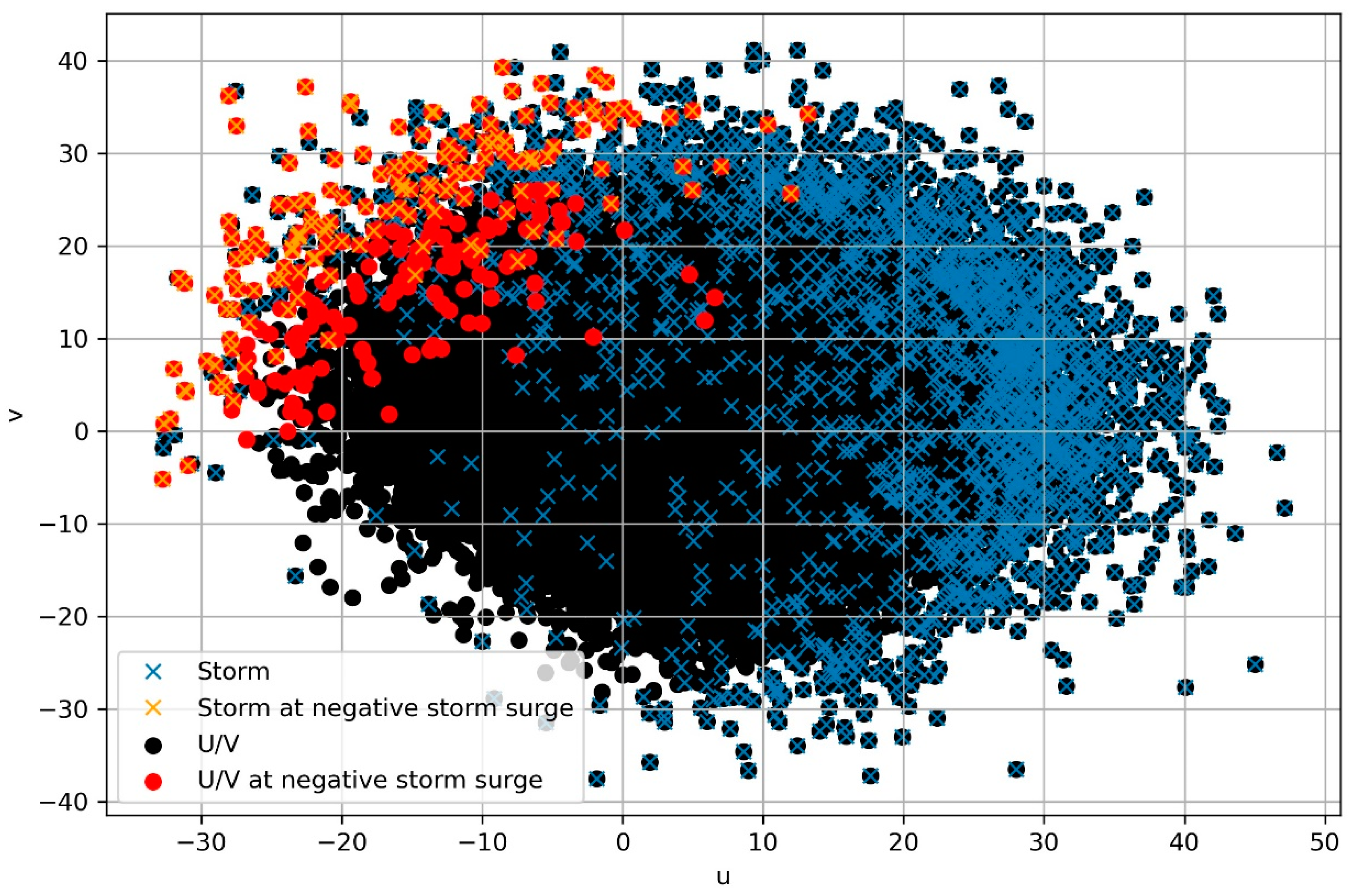


References
- HTG. Empfehlungen des Arbeitsausschusses “Ufereinfassungen” Häfen und Wasserstraßen EAU 2020: (inkl. E-Book als PDF), 12th ed.; Ernst Wilhelm & Sohn: Berlin, Germany, 2020. [Google Scholar]
- Port of Hamburg “Seaborne Cargo Handling”. Available online: https://www.hafen-hamburg.de/en/statistics/seabornecargohandling/ (accessed on 25 April 2022).
- Hamburg Port Authority. Gewässerkundliche Information—Gewässerkundliches Jahr 2019—Pegel St. Pauli: 1 November 2018–31 October 2019. Available online: https://www.hamburg-port-authority.de/fileadmin/user_upload/Gewaesserkundliche_Information_2019.pdf (accessed on 9 June 2022).
- Gurumurthy, P.; Orton, P.M.; Talke, S.A.; Georgas, N.; Booth, J.F. Mechanics and Historical Evolution of Sea Level Blowouts in New York Harbor. JMSE 2019, 7, 160. [Google Scholar] [CrossRef]
- Gönnert, G.; Dube, S.K.; Murty, T.; Siefert, W. 7. Storm Surges generated by Extra-Tropical Cyclones—Case Studies. Die Küste—Sonderh. Glob. Storm Surges 2001, 63, 455–546. [Google Scholar]
- Sztobryn, M.; Weidig, B.; Stanislawczyk, I. Niedrigwasser in der Südlichen Ostsee (Westlicher und Mittlerer Teil); Bundesamt für Seeschifffahrt und Hydrographie: Hamburg, Germany, 2009; Volume 45.
- Campetella, C.M.; D’Onofrio, E.; Cerne, S.B.; Fiore, M.E.; Possia, N.E. Negative storm surges in the port of Buenos Aires. Int. J. Climatol. 2007, 27, 1091–1101. [Google Scholar] [CrossRef]
- Wicks, A.J.; Atkinson, D.E. Identification and classification of storm surge events at Red Dog Dock, Alaska, 2004–2014. Nat. Hazards 2016, 86, 877–900. [Google Scholar] [CrossRef]
- Wolski, T.; Wiśniewski, B. Geographical diversity in the occurrence of extreme sea levels on the coasts of the Baltic Sea. J. Sea Res. 2020, 159, 101890. [Google Scholar] [CrossRef]
- Geelhoed, P. Negative Surges in the Southern North Sea. Int. Hydrogr. Rev. 1973, 61–73. [Google Scholar]
- Conte, D.; Lionello, P. Characteristics of large positive and negative surges in the Mediterranean Sea and their attenuation in future climate scenarios. Glob. Planet. Change 2013, 111, 159–173. [Google Scholar] [CrossRef]
- Pugh, D.; Woodworth, P. Sea-Level Science: Understanding Tides, Surges, Tsunamis and Mean Sea-Level Changes; Cambridge University Press: Cambridge, UK, 2014. [Google Scholar]
- Booth, J.F.; Narinesingh, V.; Towey, K.L.; Jeyaratnam, J. Storm Surge, Blocking, and Cyclones: A Compound Hazards Analysis for the Northeast United States. J. Appl. Meteorol. Climatol. 2021, 60, 1531–1544. [Google Scholar] [CrossRef]
- Fox-Kemper, B.; Hewitt, H.T.; Xiao, C.; Aðalgeirsdóttir, G.; Drijfhout, S.S.; Edwards, T.L.; Golledge, N.R.; Hemer, M.; Kopp, R.E.; Krinner, G.; et al. Ocean, Cryosphere and Sea Level Change. In Climate Change 2021: The Physical Science Basis. Contribution of Working Group I to the Sixth Assessment Report of the Intergovernmental Panel on Climate Change; Cambridge University Press: Cambridge, UK, 2021; Volume 6, pp. S.1211–S.1362. [Google Scholar] [CrossRef]
- Garner, G.G.; Kopp, R.E.; Hermans, T.; Slangen, A.B.A.; Koubbe, G.; Turilli, M.; Jha, S.; Edwards, T.L.; Levermann, A.; Nowikci, S.; et al. Framework for Assessing Changes to Sea-level (FACTS). Geosci. Model Dev. 2021. in prep.. [Google Scholar]
- Garner, G.G.; Hermans, T.; Kopp, R.E.; Slangen, A.B.A.; Edwards, T.L.; Levermann, A.; Nowikci, S.; Palmer, M.D.; Smith, C.; Fox-Kemper, B.; et al. IPCC AR6 Sea-Level Rise Projections. Version 20210809. Available online: https://podaac.jpl.nasa.gov/announcements/2021-08-09-Sea-level-projections-from-the-IPCC-6th-Assessment-Report (accessed on 16 May 2022).
- Khojasteh, D.; Glamore, W.; Heimhuber, V.; Felder, S. Sea level rise impacts on estuarine dynamics: A review. Sci. Total Environ. 2021, 780, 146470. [Google Scholar] [CrossRef]
- Rudolph, E. Storm Surges in the Elbe, Jade-Weser and Ems Estuaries. Die Küste 2014, 81, 291–300. [Google Scholar]
- Seiffert, R.; Hesser, F. Investigating Climate Change Impacts and Adaptation Strategies in German Estuaries. Die Küste 2014, 81, 551–563. [Google Scholar]
- Kučerová, M.; Beck, C.; Philipp, A.; Huth, R. Trends in frequency and persistence of atmospheric circulation types over Europe derived from a multitude of classifications. Int. J. Climatol. 2017, 37, 2502–2521. [Google Scholar] [CrossRef]
- Stryhal, J.; Huth, R. Trends in winter circulation over the British Isles and central Europe in twenty-first century projections by 25 CMIP5 GCMs. Clim. Dyn. 2018, 52, 1063–1075. [Google Scholar] [CrossRef]
- Huguenin, M.F.; Fischer, E.M.; Kotlarski, S.; Scherrer, S.C.; Schwierz, C.; Knutti, R. Lack of Change in the Projected Frequency and Persistence of Atmospheric Circulation Types Over Central Europe. Geophys. Res. Lett. 2020, 47, e2019GL086132. [Google Scholar] [CrossRef]
- Donat, M.G.; Leckebusch, G.C.; Pinto, J.G.; Ulbrich, U. European storminess and associated circulation weather types: Future changes deduced from a multi-model ensemble of GCM simulations. Clim. Res. 2010, 42, 27–43. [Google Scholar] [CrossRef]
- Plavcová, E.; Kyselý, J. Projected evolution of circulation types and their temperatures over Central Europe in climate models. Theor. Appl. Climatol. 2013, 114, 625–634. [Google Scholar] [CrossRef]
- Riediger, U.; Gratzki, A. Future weather types and their influence on mean and extreme climate indices for precipitation and temperature in Central Europe. Meteorol. Z. 2014, 23, 231–252. [Google Scholar] [CrossRef]
- Demuzere, M.; Werner, M.; van Lipzig, N.P.M.; Roeckner, E. An analysis of present and future ECHAM5 pressure fields using a classification of circulation patterns. Int. J. Climatol. 2009, 29, 1796–1810. [Google Scholar] [CrossRef]
- Arns, A.; Wahl, T.; Dangendorf, S.; Jensen, J. The impact of sea level rise on storm surge water levels in the northern part of the German Bight. Coast. Eng. 2015, 96, 118–131. [Google Scholar] [CrossRef]
- Müller-Navarra, S.H.; Giese, H. Improvements of an empirical model to forecast wind surge in the German Bight. Ocean Dyn. 1999, 51, 385–405. [Google Scholar] [CrossRef]
- WSV. Zentrales Datenmanagement (ZDM): Küstendaten. Available online: https://www.kuestendaten.de/DE/Services/Messreihen_Dateien_Download/Download_Zeitreihen_node.html (accessed on 9 June 2022).
- Hersbach, H.; Bell, B.; Berrisford, P.; Hirahara, S.; Horányi, A.; Muñoz-Sabater, J.; Nicolas, J.; Peubey, C.; Radu, R.; Schepers, D. The ERA5 global reanalysis. Q. J. R. Meteorol. Soc. 2020, 146, 1999–2049. [Google Scholar] [CrossRef]
- ECMWF. ERA5. Available online: https://confluence.ecmwf.int/display/CKB/ERA5 (accessed on 12 August 2021).
- Bell, B.; Hersbach, H.; Simmons, A.; Berrisford, P.; Dahlgren, P.; Horányi, A.; Muñoz-Sabater, J.; Nicolas, J.; Radu, R.; Schepers, D.; et al. The ERA5 global reanalysis: Preliminary extension to 1950. Q. J. R. Meteorol. Soc. 2021, 147, 4186–4227. [Google Scholar] [CrossRef]
- Schade, N.H.; Sadikni, R.; Jahnke-Bornemann, A.; Hinrichs, I.; Gates, L.; Tinz, B.; Stammer, D. The KLIWAS North Sea climatology. Part II: Assessment against global reanalyses. J. Atmos. Ocean. Technol. 2017, 35, 127–145. [Google Scholar] [CrossRef]
- Wyser, K.; Koenigk, T.; Fladrich, U.; Fuentes-Franco, R.; Karami, M.P.; Kruschke, T. The SMHI Large Ensemble (SMHI-LENS) with EC-Earth3.3.1. Geosci. Model Dev. 2021, 14, 4781–4796. [Google Scholar] [CrossRef]
- Döscher, R.; Acosta, M.; Alessandri, A.; Anthoni, P.; Arsouze, T.; Bergman, T.; Bernardello, R.; Boussetta, S.; Caron, L.-P.; Carver, G.; et al. The EC-Earth3 Earth system model for the Coupled Model Intercomparison Project 6. Geosci. Model Dev. 2022, 15, 2973–3020. [Google Scholar] [CrossRef]
- Eyring, V.; Bony, S.; Meehl, G.A.; Senior, C.A.; Stevens, B.; Stouffer, R.J.; Taylor, K.E. Overview of the Coupled Model Intercomparison Project Phase 6 (CMIP6) experimental design and organization. Geosci. Model Dev. 2016, 9, 1937–1958. [Google Scholar] [CrossRef]
- O’Neill, B.C.; Tebaldi, C.; van Vuuren, D.P.; Eyring, V.; Friedlingstein, P.; Hurtt, G.; Knutti, R.; Kriegler, E.; Lamarque, J.-F.; Lowe, J.; et al. The Scenario Model Intercomparison Project (ScenarioMIP) for CMIP6. Geosci. Model Dev. 2016, 9, 3461–3482. [Google Scholar] [CrossRef]
- Bundesamt für Seeschifffahrt und Hydrographie “Sturmfluten”. Available online: https://www.bsh.de/DE/THEMEN/Wasserstand_und_Gezeiten/Sturmfluten/sturmfluten_node.html (accessed on 12 May 2020).
- Gerber, M.; Ganske, A.; Müller-Navarra, S.; Rosenhagen, G. Categorisation of Meteorological Conditions for Storm Tide Episodes in the German Bight. Meteorol. Z. 2016, 25, 447–462. [Google Scholar] [CrossRef]
- Lamb, H.H. Types and spells of weather around the year in the British Isles: Annual trends, seasonal structure of the year, singularities. Q. J. R. Meteorol. Soc. 1950, 76, 393–429. [Google Scholar] [CrossRef]
- Jenkinson, A.F.; Collison, F.P. An initial climatology of gales over the North Sea. Synop. Climatol. Branch Memo. 1977, 62, 18. [Google Scholar]
- Loewe, P. Nordseezustand 2003; Bundesamt für Seeschifffahrt und Hydrographie: Hamburg/Rostock, Germany, 2005; Volume 38.
- Loewe, P. System Nordsee—Zustand 2005 im Kontext Langzeitlicher Entwicklungen; Bundesamt für Seeschifffahrt und Hydrographie: Hamburg/Rostock, Germany, 2009; Volume 44.
- Federal Agency for Cartography and Geodesy. 2021. Available online: https://sgx.geodatenzentrum.de/web_public/Datenquellen_TopPlusOpen_30.09.2021.pdf (accessed on 12 May 2020).
- Koziar, C.; Renner, V. MUSE Modellgestützte Untersuchungen zu Sturmfluten mit sehr geringen Eintrittswahrscheinlichkeiten–Teilprojekt: Numerische Berechnung physikalisch konsistenter Wetterlagen mit Atmosphärenmodellen; Deutscher Wetterdienst: Offenbach, Germany, 2005. [CrossRef]
- Ganske, A.; Fery, N.; Gaslikova, L.; Grabemann, I.; Weisse, R.; Tinz, B. Identification of extreme storm surges with high-impact potential along the German North Sea coastline. Ocean Dyn. 2018, 68, 1371–1382. [Google Scholar] [CrossRef]
- Casulli, V. A high-resolution wetting and drying algorithm for free-surface hydrodynamics. Int. J. Numer. Meth. Fluids 2009, 60, 391–408. [Google Scholar] [CrossRef]
- Smith, S.D.; Banke, E.G. Variation of the sea surface drag coefficient with wind speed. Q. J. R. Meteorol. Soc. 1975, 101, 665–673. [Google Scholar] [CrossRef]
- Sievers, J.; Malte, R.; Milbradt, P. EasyGSH-DB: Bathymetrie (1996–2016); Bundesanstalt für Wasserbau: Karlsruhe, Germany, 2020. [CrossRef]
- Bollmeyer, C.; Keller, J.D.; Ohlwein, C.; Wahl, S.; Crewell, S.; Friederichs, P.; Hense, A.; Keune, J.; Kneifel, S.; Pscheidt, I.; et al. Towards a high-resolution regional reanalysis for the European CORDEX domain. Q.J.R. Meteorol. Soc. 2015, 141, 1–15. [Google Scholar] [CrossRef]
- DWD. OPENDATA. Available online: https://opendata.dwd.de/climate_environment/REA/COSMO_REA6/ (accessed on 1 June 2022).
- Ganske, A.; Rosenhagen, G. Downscaling von Windfeldern aus Lokalmodellen auf die Tideelbe. Die Küste 2012, 79, 125–140. [Google Scholar]
- Borsche, M.; Kaiser-Weiss, A.K.; Kaspar, F. Wind speed variability between 10 and 116 m height from the regional reanalysis COSMO-REA6 compared to wind mast measurements over Northern Germany and the Netherlands. Adv. Sci. Res. 2016, 13, 151–161. [Google Scholar] [CrossRef]
- Zijl, F.; Verlaan, M.; Gerritsen, H. Improved water-level forecasting for the Northwest European Shelf and North Sea through direct modelling of tide, surge and non-linear interaction. Ocean Dyn. 2013, 63, 823–847. [Google Scholar] [CrossRef]
- Zijl, F.; Sumihar, J.; Verlaan, M. Application of data assimilation for improved operational water level forecasting on the northwest European shelf and North Sea. Ocean Dyn. 2015, 65, 1699–1716. [Google Scholar] [CrossRef]
- Rasquin, C.; Seiffert, R.; Wachler, B.; Winkel, N. The significance of coastal bathymetry representation for modelling the tidal response to mean sea level rise in the German Bight. Ocean Sci. 2020, 16, 31–44. [Google Scholar] [CrossRef]
- Wahl, T.; Jensen, J.; Frank, T.; Haigh, I.D. Improved estimates of mean sea level changes in the German Bight over the last 166 years. Ocean Dyn. 2011, 61, 701–715. [Google Scholar] [CrossRef]
- Siefert, W. Tiden und Sturmfluten in der Elbe und ihren Nebenflüssen: Die Entwicklung von 1950 bis 1997 und ihre Ursachen. Die Küste 1998, 60, S.1–S.115. [Google Scholar]
- Weilbeer, H.; Winterscheid, A.; Strotmann, T.; Entelmann, I.; Shaikh, S.; Vaessen, B. Analyse der hydrologischen und morphologischen Entwicklung in der Tideelbe für den Zeitraum von 2013 bis 2018. 73. Die Küste 2021, 89, 57–129. [Google Scholar] [CrossRef]
- Benninghoff, M.; Winter, C. Recent morphologic evolution of the German Wadden Sea. Sci. Rep. 2019, 9, 9293. [Google Scholar] [CrossRef] [PubMed]
- Friedrichs, C.T. Tidal Flat Morphodynamics: A Synthesis. Treatise Estuar. Coast. Sci. 2011, 137–170. [Google Scholar] [CrossRef]
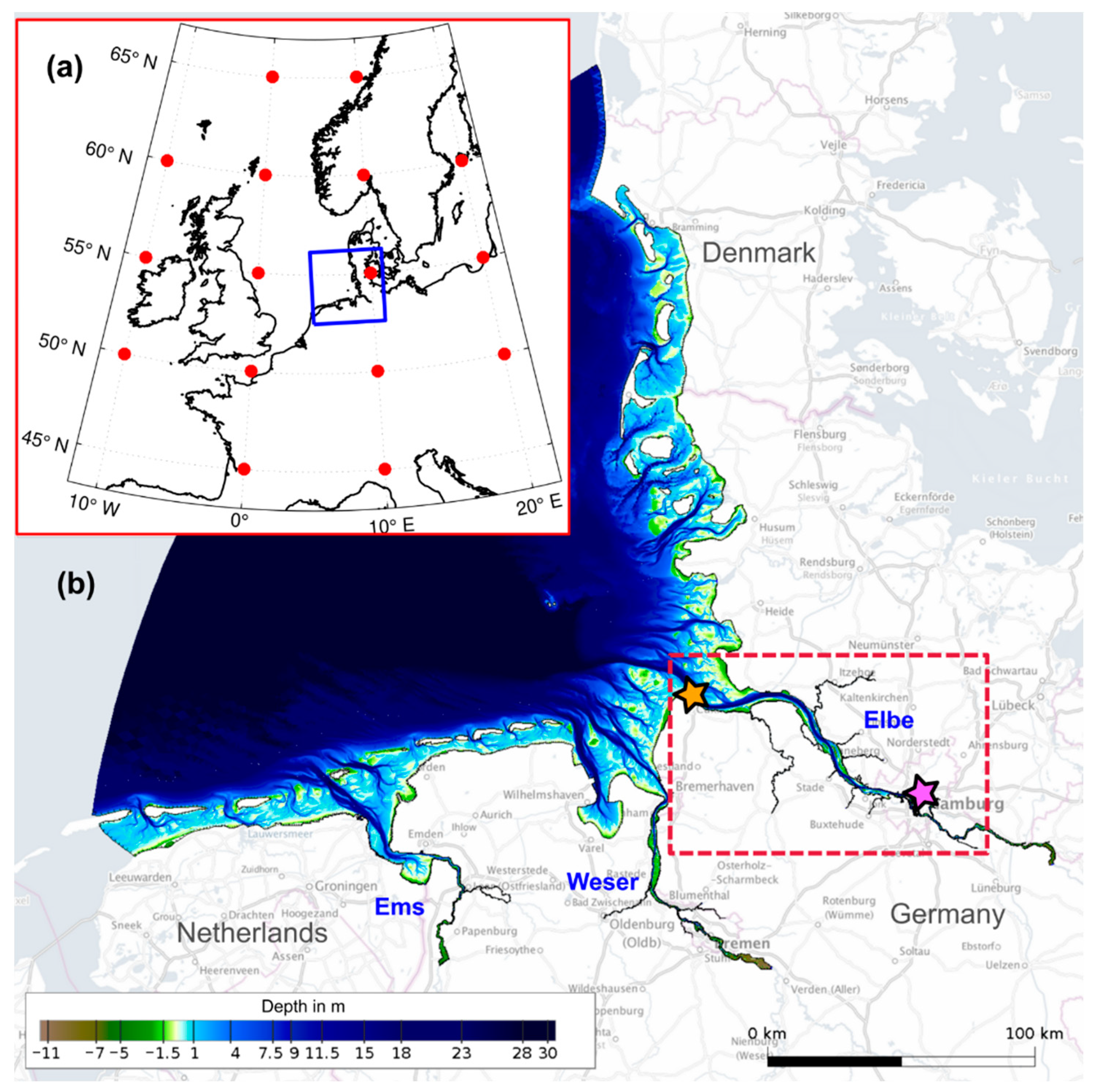
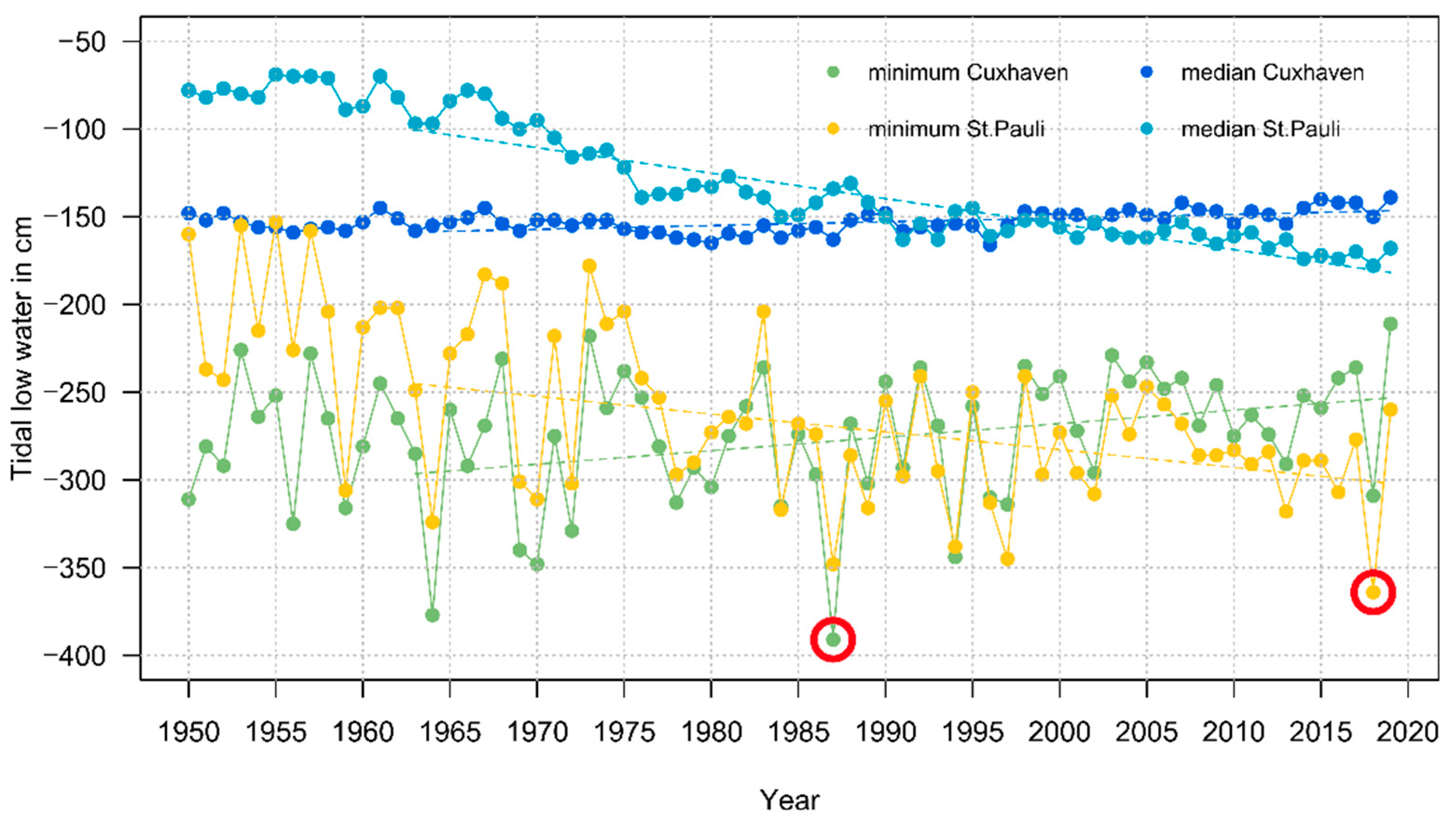
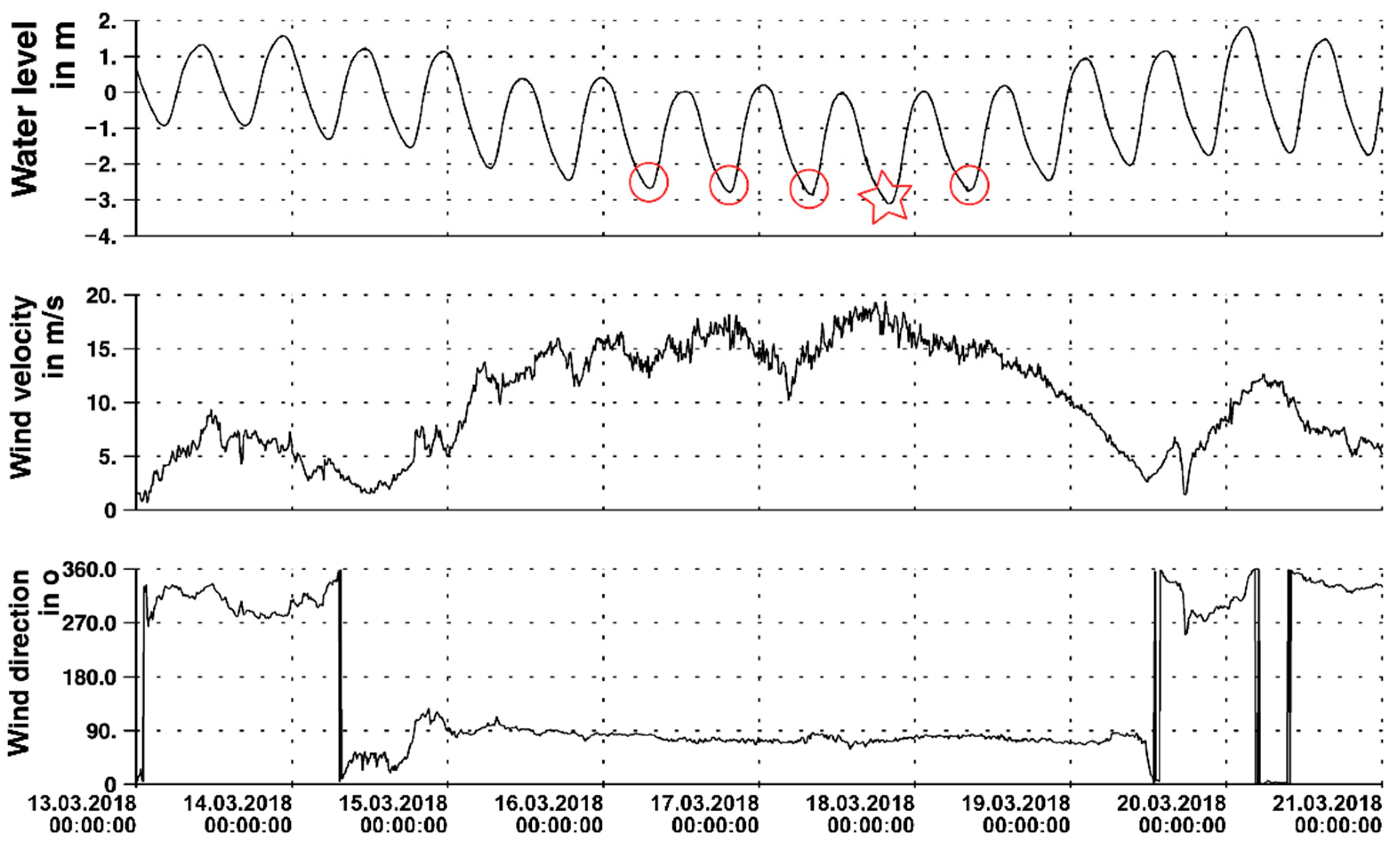
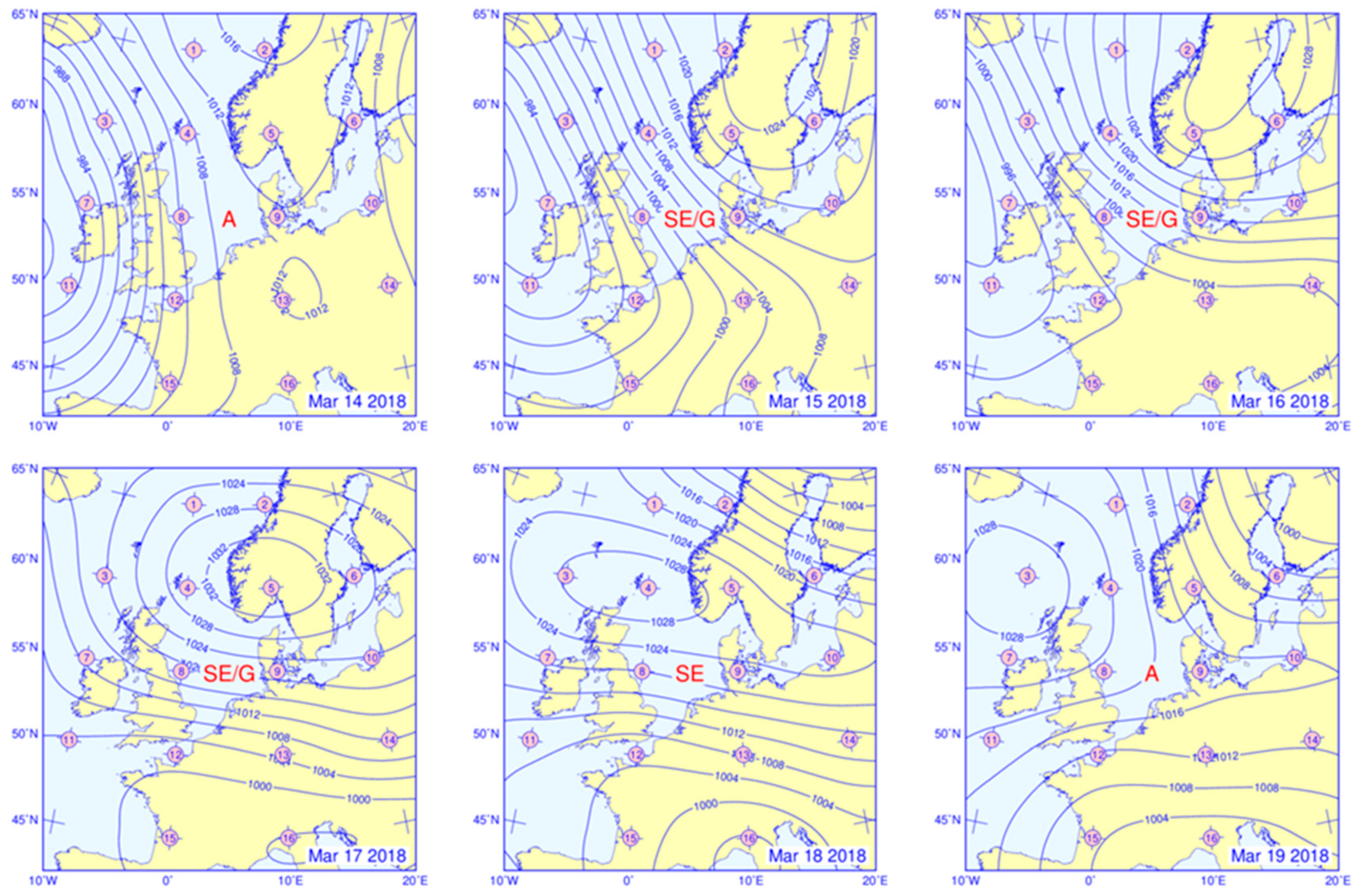
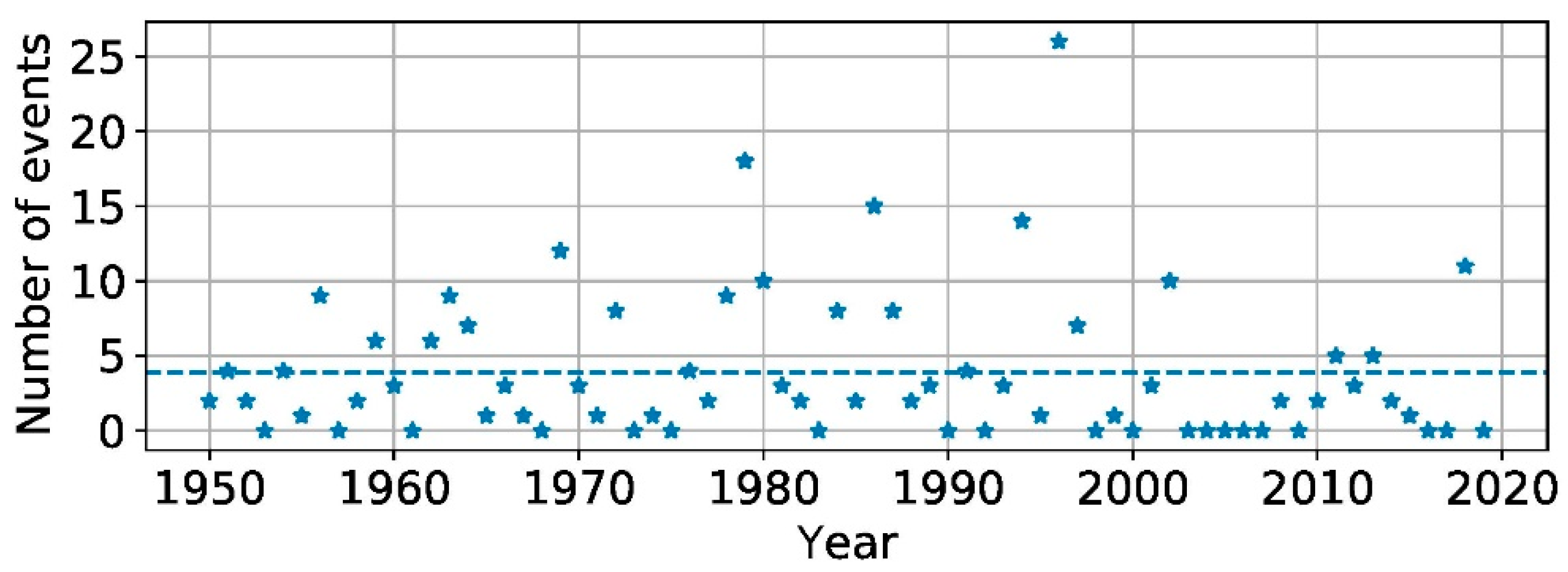
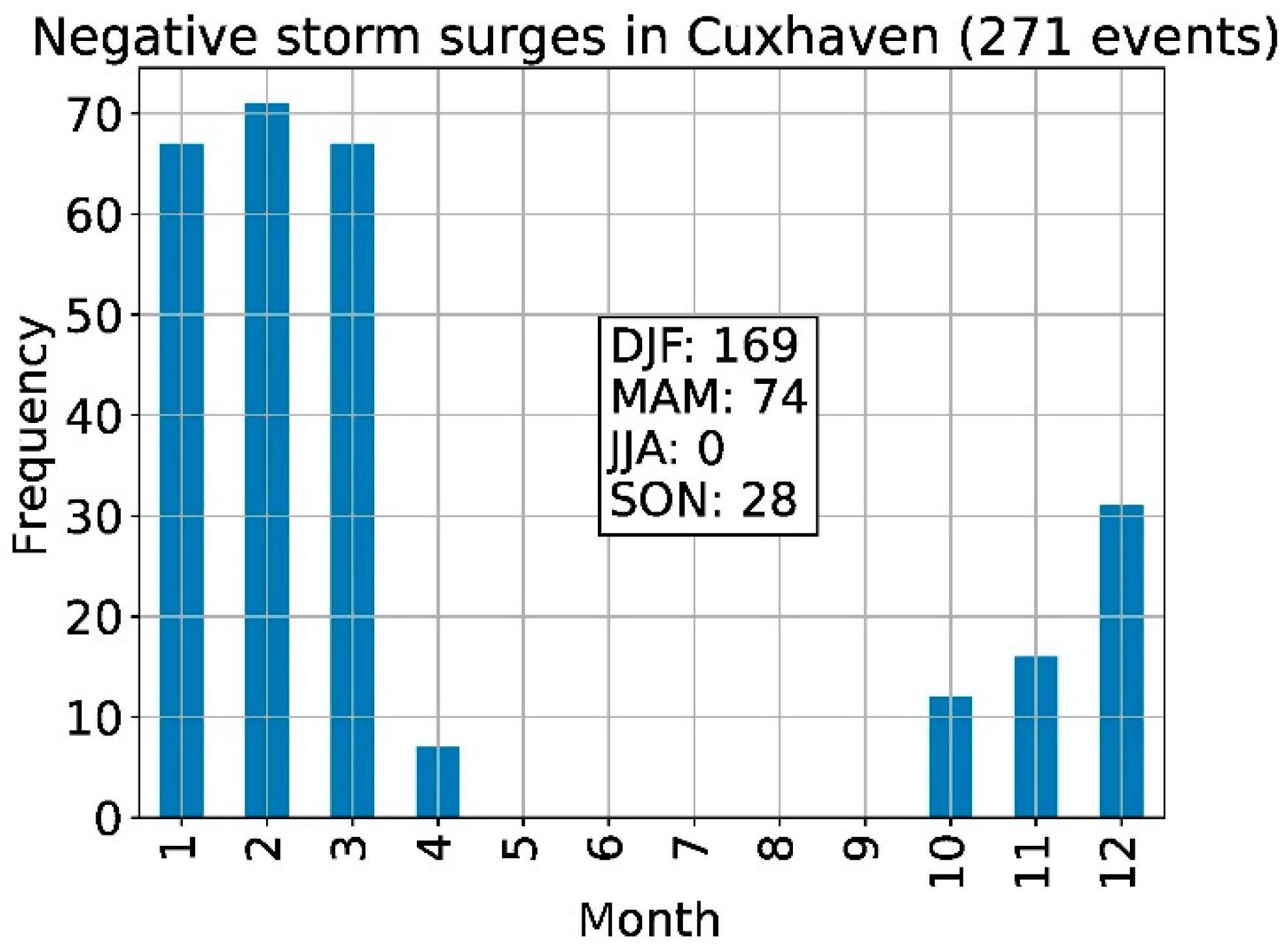

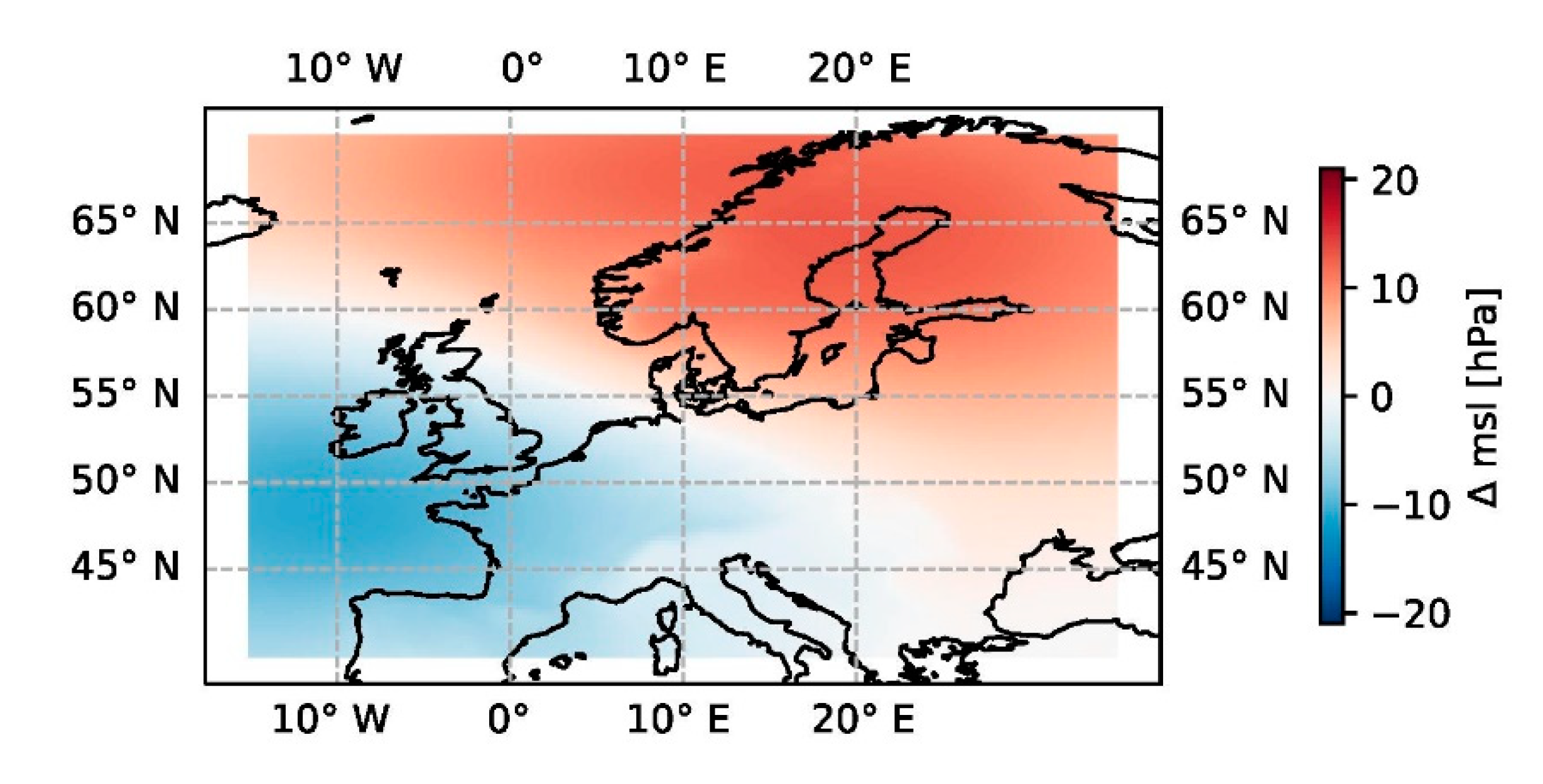
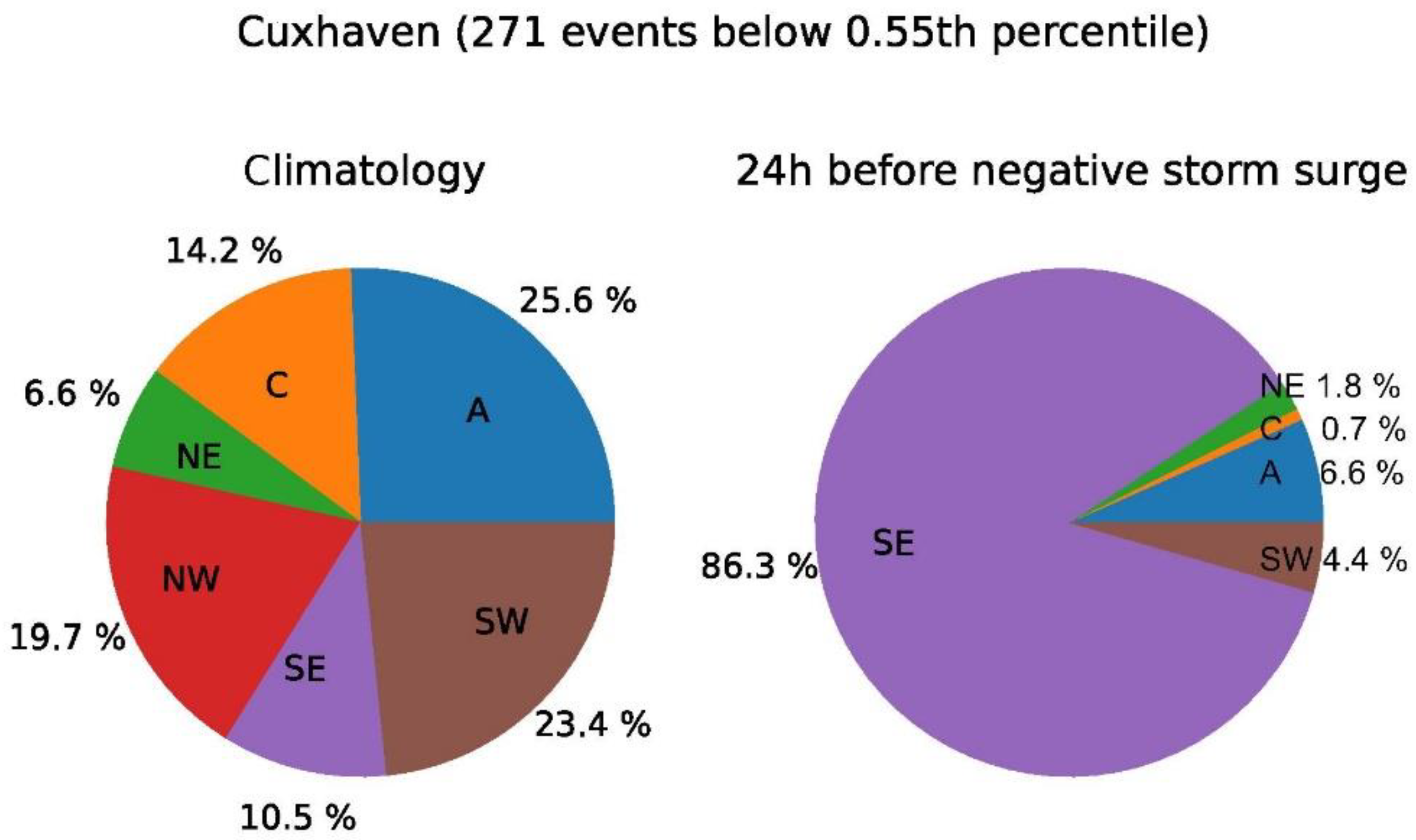

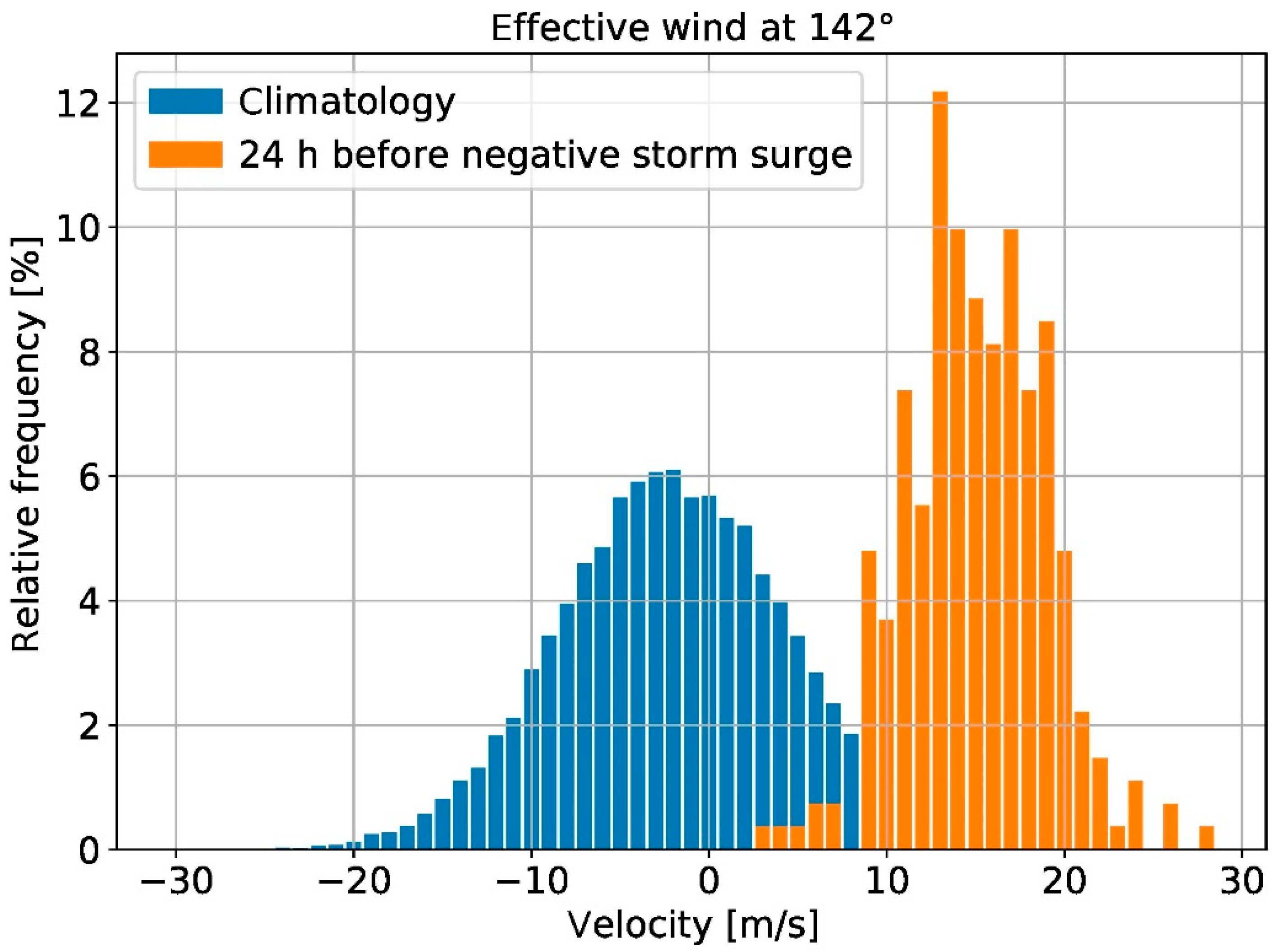
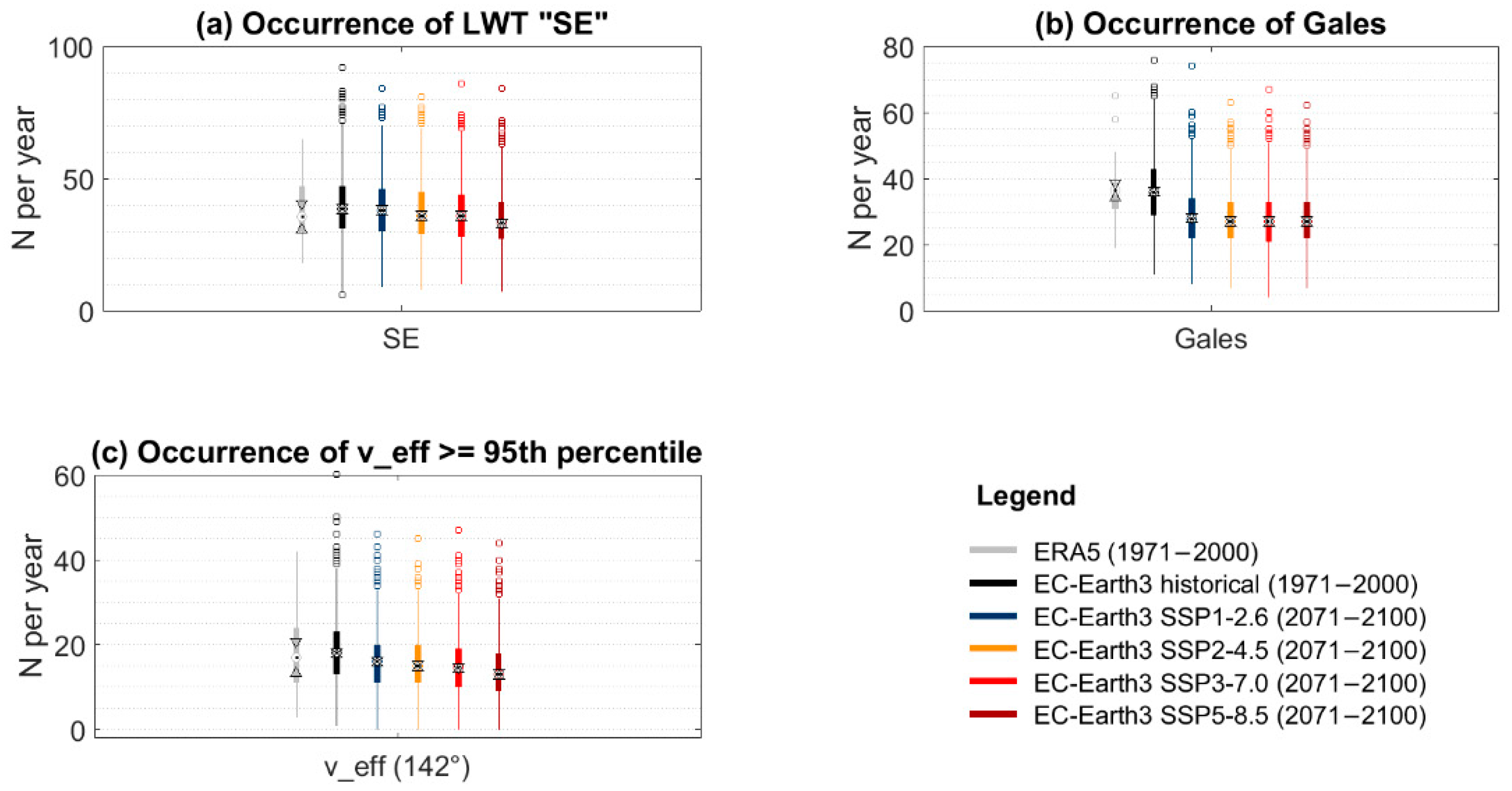

Publisher’s Note: MDPI stays neutral with regard to jurisdictional claims in published maps and institutional affiliations. |
© 2022 by the authors. Licensee MDPI, Basel, Switzerland. This article is an open access article distributed under the terms and conditions of the Creative Commons Attribution (CC BY) license (https://creativecommons.org/licenses/by/4.0/).
Share and Cite
Jensen, C.; Mahavadi, T.; Schade, N.H.; Hache, I.; Kruschke, T. Negative Storm Surges in the Elbe Estuary—Large-Scale Meteorological Conditions and Future Climate Change. Atmosphere 2022, 13, 1634. https://doi.org/10.3390/atmos13101634
Jensen C, Mahavadi T, Schade NH, Hache I, Kruschke T. Negative Storm Surges in the Elbe Estuary—Large-Scale Meteorological Conditions and Future Climate Change. Atmosphere. 2022; 13(10):1634. https://doi.org/10.3390/atmos13101634
Chicago/Turabian StyleJensen, Corinna, Tara Mahavadi, Nils H. Schade, Ingo Hache, and Tim Kruschke. 2022. "Negative Storm Surges in the Elbe Estuary—Large-Scale Meteorological Conditions and Future Climate Change" Atmosphere 13, no. 10: 1634. https://doi.org/10.3390/atmos13101634
APA StyleJensen, C., Mahavadi, T., Schade, N. H., Hache, I., & Kruschke, T. (2022). Negative Storm Surges in the Elbe Estuary—Large-Scale Meteorological Conditions and Future Climate Change. Atmosphere, 13(10), 1634. https://doi.org/10.3390/atmos13101634





